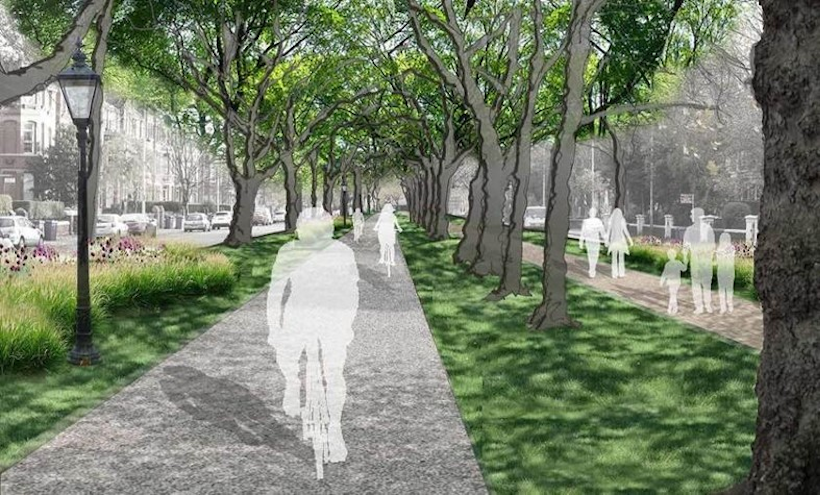Back in 2014, in response to Government funding cuts to local authorities, the Mayor of Liverpool commissioned a Green and Open Spaces Review to look at future ways to fund parks maintenance. Two of the key review recommendations were to seek external funding and to consider opportunities to create green corridors across the city for connectivity.
In response Liverpool successfully applied for funding under the Horizon 2020 URBAN GreenUP project to retrofit, test and monitor a range of green infrastructure to help the city adapt to future climate change impacts. Working together with 2 other front runner cities: Valladolid in Spain and Izmir in Turkey the project has a further 5 follower cities in, Germany, Italy, Vietnam, South America, and China and focusses on promoting the multiple environmental, social and economic benefits associated with green infrastructure or Nature Based Solutions.
Dr Juliet Staples, Senior Project Manager of the scheme at Liverpool says, “Working collaboratively with Urban GreenUP partners to develop aspects such as methodology and performance indicators means we can intelligently install the right type of green infrastructure in the most appropriate place.”

“To help understand the environmental, social and economic impacts associated with these works we’ve undertake a year-long baseline monitoring programme for a range of parameters and will continue to monitor these for 2 years after installation to help quantify the multiple benefits associated with nature-based solutions.“
By sharing the learning from front runner cities, the follower cities will be able to replicate different nature based solutions in their countries. A key part of the project is to create a methodology behind urban greening schemes that other cities can follow.
Working with the team at Liverpool Council, we created a living wall proposal that took into account their aim to reduce anti-social behaviour in the specific area, increase the biodiversity and improve the air quality to create a healthier, safer and more attractive location. This living green wall stretching the length of the car park façade on Parr Street is one of the first installations of many projects, that together, will form a ‘green corridor’ extending to the coast.
A big living wall with an even bigger purpose, we created a plant palette using 23 different plant varieties, designed to give colour and interest all year round whilst providing sources of nectar and pollination. Taking advantage of every square metre, the majority of plants in the wall have an ecological value, providing berries (strawberries!), seed and fodder.
Including a number of native species, the planting palette very much supports the local area’s flora and fauna.

Aesthetically, the aim was to create something that replicated what would be expected in a rural scene. With the area experiencing some anti-social behaviour, the need to create a biophilic space was just as important as the environmental considerations.
Alongside biodiversity, improving the air quality was one of the driving factors behind the design which is why within the plant palette there are a large number of species that are particularly efficient at absorbing particulate matter, having leaf surfaces with very fine hairs that trap polluting particles.
Working with the University of Liverpool, we’ll be monitoring the improvements and successes in not only the air quality and biodiversity but also in people’s perceptions and any resulting regeneration initiatives in the local area.
We’re excited to be a part of the beginning of a green avenue stretching to the coast, and an even bigger scheme worldwide!
The community love this wall too. Senior Project Manager, Juliet says, “we’ve had a lot of people stopping to ask questions and to say how much they are enjoying having the green wall there.” She adds "I always wanted to install a green wall in the city and it’s great that this one is so accessible and interactive. Can’t wait to be back at work in the city so I can visit it more often."
“I love that you can get up close to interact with the plants but it’s equally good from a distance when you can see the patterning of planting. I also like that it’s on an everyday building in an unexpected location, showing that this type of green infrastructure can be used across a city.”
Using systems based on nature is a key part to the success of the scheme, leading to incorporation of an Viritopia Living Wall. Dr Staples stresses this point “For URBAN GreenUP this aspect is very important as it forms the basis of the research and innovation project funding. There are lots of opportunities to green cities and make them more pleasant places to live. Doing this in an informed way, that allows you to introduce the right type of nature based solution in a location, has the added benefit of increasing the associated environmental, social and economic benefits and also helps make the city more resilient to the future predicted impacts of climate change.”
Plants are a vital part of creating a green community, which is why we’re committed to creating greener, cleaner and healthier spaces for communities across the world. If you'd like to keep up to date on our latest projects, research findings and live online events, subscribe to our mailing list.


